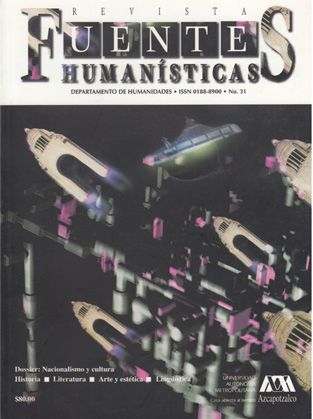El amor por los distantes: de Tlacaélel, Valeriano, Vasconcelos en nuestros días
Abstract
El nacionalismo es, en principio, una idea. Una idea que, en su mejor percepción, trasciende orígenes étnicos, lingüísticos o de clase, e identifica una diversidad cultural bajo el manto de un proyecto solidario común. En México, y en el conjunto de América Latina, es algo que no hemos conseguido de manera definitiva. Voluntad y cultura son los ingredientes necesarios para consolidar esa idea, en este sentido, el propósito de este ensayo es hacer visible la secuencia cultural subterránea entre Tlacaélel, quien fundara el proyecto cultural y civilizatorio mexica en el curso del siglo XV, Antonio Valeriano, con Guadalupe en el Tepeyac, en el siglo XVI y José Vasconcelos con su proyecto educativo y su pertinencia en nuestros días para la consolidación de la idea de una verdadera nación en México, plural e incluyente simultáneamente, es el propósito de este ensayo.Downloads
Authors who publish in this journal accept the following conditions:
Fuentes Humanísticas is licensed under a Creative Commons Attribution-NonCommercial-ShareAlike 4.0 International (CC BY-NC-SA 4.0) license.
Authors retain copyright and grant the journal the right of first publication, with the work licensed under the Creative Commons Attribution license CC BY-NC-SA 4.0, which allows third parties to:
Share — copy and redistribute the material in any medium or format.
Adapt — remix, transform, and build upon the material.
The licensor cannot revoke these freedoms as long as you follow the license terms.
Under the following terms:
Attribution — You must give appropriate credit, provide a link to the license, and indicate if changes were made. You may do so in any reasonable manner, but not in any way that suggests the licensor endorses you or your use.
NonCommercial — You may not use the material for commercial purposes.
ShareAlike — If you remix, transform, or build upon the material, you must distribute your contribution under the same license as the original.
No additional restrictions — You may not apply legal terms or technological measures that legally restrict others from doing anything the license permits.
Authors may enter into other independent and additional agreements for the non-exclusive distribution of the published version of the article in this journal (e.g., placing it in an institutional repository) as long as they clearly indicate that the work was first published in this journal.






